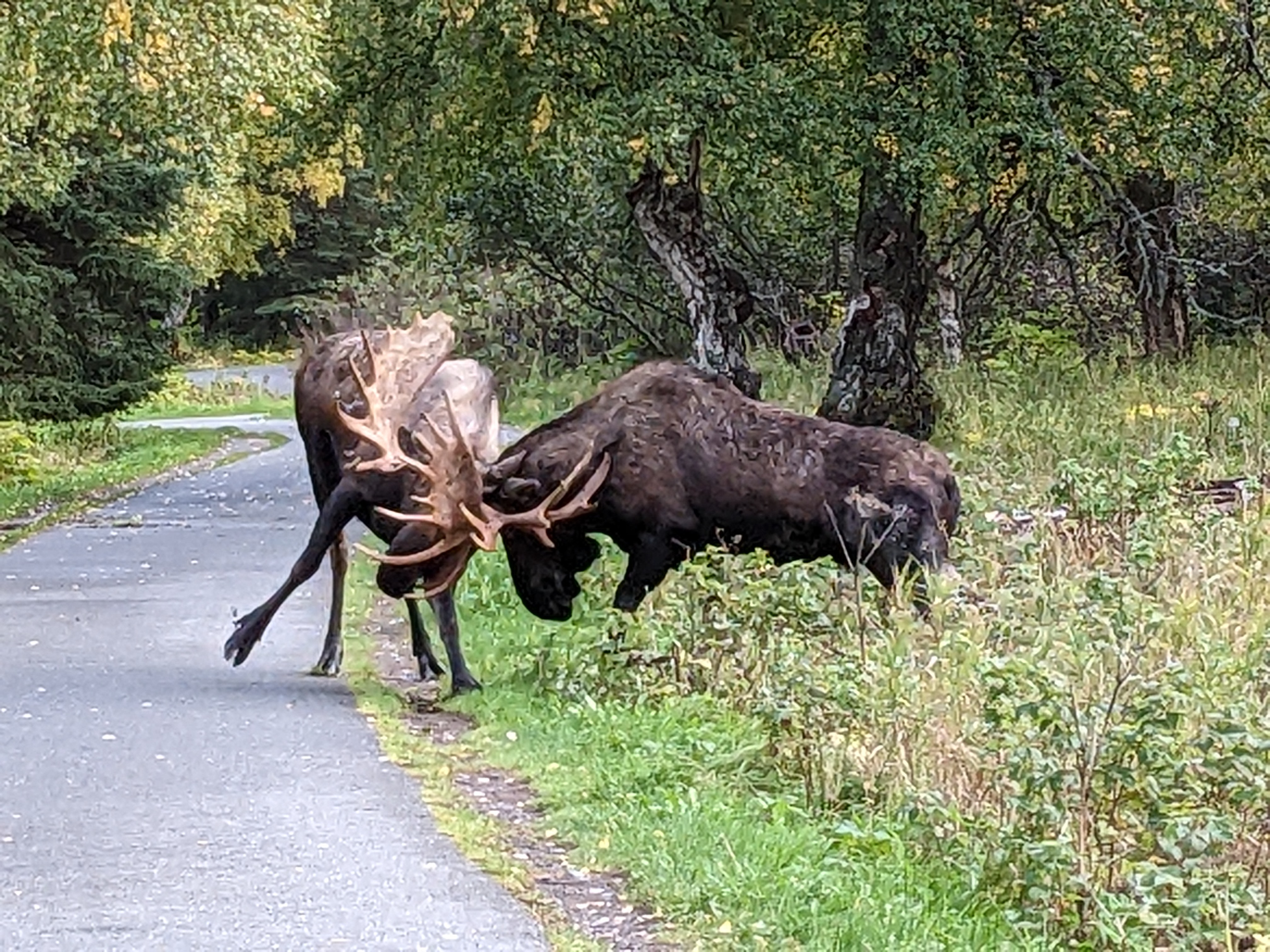The Dogs Of University Lake
Dog Park Doggos. Click or touch the first photo, then use arrows to scroll. Enjoy!
Dog Park Doggos. Click or touch the first photo, then use arrows to scroll. Enjoy!

Peaceful, innit? No crowds, no talking heads, no consternation, no judgement of any kind. A simple winter walk with Black Dog on a beach all to ourselves. A ten minute drive from home. I don’t think I’ll ever become jaded to it. It hasn’t happened in over thirty years, likely it never will.
We were in northwest Washington for a spell (not Seattle), looking for a home we may want to buy, somewhere else to live our lives for a while. It’s truly shocking what money won’t buy. We don’t have big asks. A modern, well-appointed kitchen (needn’t be a Chef’s kitchen), a private office for me (french doors would be nice), a spacious master primary bedroom with a spa-like shower in the en-suite (we’re spoiled in our current home), one or two spare bedrooms, a cozy living room, and a modest-sized fenced backyard. Prefer a one-story, but two would work. A view would be nice, so long as it’s not of a neighbor’s property awaiting condemnation by the municipality. We visited a property with such a view, in a walk-able neighborhood, one possibly undergoing a slow gentrification (emphasis slow). You know what I’m talking about. With nearby coffee houses that brew with sustainably sourced beans, boutique grocers who feature locally grown produce, pocket parks and ball fields, streets lined with old growth fruit trees, little free libraries, the whole community-vibe thing. What’s not to like? For one, the house. It was an old, long and narrow home, recently re-modeled (flipped) with slightly better than builder-grade finishes, uninspired gray and white accents everywhere, a usable but small kitchen, and a meh primary bedroom and bath, neither of which anyone would call spacious. The entire house couldn’t of been more than 1400 square feet. It backed to an alley where you’d expect a garage if there was one (there wasn’t). A fenced side yard with a postage stamp-sized lawn. And then there was that eye-sore next door. The front and back yards were piled high with crap and scrap that appeared to have accumulated since the Civil war. Why were we looking at starter homes? We weren’t. That’s what $700K buys you in an “up-and-coming” neighborhood. I needed help lifting my jaw off the floor. We piled back into our agent’s Audi and got the hell out of there. As we sped away he said he just wanted to show us that place because we’d told him we may be interested in a craftsman-style home with character in an established community.
After a few days in Washington we flew to Milwaukee, my hometown. HW and I splurged on dinner at Eddie Martini’s, an old-school supper club about four miles from the apartments (since torn down) where Dahmer committed his heinous murders . A quick reminder of our visit to Eddies last year was all that was needed to pique the memory of our server – “Oh, that’s right, I remember, yous guys are from Alaska.” As is our wont we ate at the bar. A linen cloth was laid, appetizers were ordered and promptly served, wine decanted. To a one the staff here are smartly dressed, impeccable in manner, always nearby at the ready to fulfill the diners’ needs. We shared an entree of Australian lamb chops with Pappardelle, portabella & shitake mushrooms, asparagus, spinach, and cognac dipping sauce. Delicious all. Eddie’s is run like a tight ship but without a hint of snobbery. The staff are eager to engage in spirited banter if prompted, which I am wont to do (sometimes to HW’s chagrin).
The following day we drove north to the Fox River valley area to visit family and friends. There must be thousands of billboards along highway 41 alone, in both directions. I don’t think there’s a single one along any roadway in Alaska. Granted, we have many fewer highways here, and most of the land adjoining the few roads we have isn’t owned by farmers, like it is in Wisconsin, where I presume farmers receive revenue from advertisers who are permitted to erect billboards in their fields? Some of the billboards were adverts to come visit the state of Michigan, where recreational pot is legal. One such billboard sported a photo of a Westie, apparently stoned, wearing a conical party hat with a chin strap. The message seemed to be: Lighten up drivers, come to Michigan, twist one up with us and party on – legally! Can’t say for sure if that was the precise message, we sped by that one so fast I didn’t grok it all. Other billboards featured preachy slogans, devout reminders to joyfully obey God’s law, interspersed with still others that advertised porn shops – take the next exit! Amusing, but puzzling at the same time. I mean, paying a farmer to erect a billboard to drive revenue to the Michigan dope industry, or to a mom-and-pop porn shop, I get. But merely for the sake of religious pandering? Where’s the money in that? Evidently, not every voter in Wisconsin is so amused

In Appleton, most everyone we visited with seemed to be doing well. Our niece and her husband threw a Packer party at their house. The Packers lost, and nobody seemed to mind much, or expect otherwise. The taco bar was excellent. Each morning I either drove or walked to a local coffee house for espresso drinks for myself and HW, about two miles round-trip from my parent’s house. I snapped this photo on one of my morning walks there. This is what $700K buys you in central Wisconsin

Better yet, instead of rubbish next door, you get a view of a pond and the community vibe of migratory geese.
Alas, we are back home now, safe and sound, grateful for family and friends, sure, but at the same time there’s no place like home. Will home change for us soon? To early to say for sure. There’s a lot of economic commotion in the world right now. Not that we ever expect it to disappear entirely, because it won’t, but mainly because more or less we are happy and content with our lives du jour right where we are. Live in the moment, be present, and don’t forget to curb your dog

And not a cow in sight. I looked. It wasn’t all sparring either. In fact, during the time I watched them they mostly ignored each other, one content to mow down what’s left of the raspberry plants while the other munched garden discards he found in the high grass. Happy Wife figured the sparring was just practice for when they get older. Probably true, being these were young boys.
There is no monopoly on common sense
On either side of the political fence
We share the same biology, regardless of ideology
Believe me when I say to you
I hope the Russians love their children too
Happy Wife gets fearful when Black Dog is that far away. The early dusting of snow in the high country makes him easy to spot though. Her concern is that he’ll get on the scent of a ground squirrel, or whatever the hell is up there squeaking “Here I am! Here I am!,” then follow it over the ridge never to be seen again. He’s never scored a kill. I kinda feel bad for him. So much for all animal behavior being consistent with the supposed one true goal of Reproductive Success. Loudly reporting your location over and over again to a seventy-five pound carnivore seems to me like the very opposite. But hey, I’m no expert in rodent biology. Although with enough training I’m sure I could see how advertising your location to predators is a feature of superior fecundity. 🙄
I know, I know, just let it go, Rod. Focus on your breath. Calm the cortex. Live in the present. Whatever the truth is, experience it. ✌
…
I had the quarterly discussion last week with our wealth advisor. I don’t envy her role, lately having to soothe client’s concerns over the evanescent valuations of their portfolios. “There there,” the glass-half-full people say, “what comes down must go up again.” I’m actually unfamiliar with any principles of physics that support such a guarantee. But if the past is any guidance, markets do oscillate over time. It’s just that the amplitude and frequency of those oscillations vary greatly. Our advisor’s reassurances are a bit more sophisticated than this. She’s not the least bit pollyanish in her approach. I like that about her. Although in the end there really are only so many ways to spin the fundamental truth that all investors right now are bobbing up and down in a vast ocean of uncertainty. Us included.

Boys will be boys.
Happy Wife captured this recently while at work. She leads bike tours for tourists. They’d just descended a long hill when all of a sudden a startled cow moose crosses the trail, and then further into the woods here comes two would-be suitors. Considerable head-butting and gnashing of antlers ensued. All the while the cow looked on from a cautious distance to see which bull would emerge victorious.
It doesn’t have to be this way you say? Well, no, I suppose not. But there it is. So I presume the boys fight because, well…how else are they to work out their differences? And the girl? She will prefer to mate the winner because nobody wants to fck a Loser.
That’s the layman’s explanation of what’s going on.
Ask an evolutionary biologist for an explanation, and you’ll hear that moose just want to make more moose. Pushed to say more, the biologist might grudgingly say that if you insist on imputing “wants” and “desires” to a moose, or any organism for that matter, from mold to man, then there is really only one desire, one “as-if” goal* of every organism, and that is to reproduce successfully. Hence, all the traits and behaviors an organism expresses are in service to that one, simple goal, period. Further, if Theodious Dobzhansky is to be believed, as I assume most biologists do, nothing in biology makes sense outside the viewpoint of evolution.
And yet, for our two uni-goal warriors up there, there’s a problem; there are not enough girls to go around. And they’re picky. And so the deeper explanation in biology for why the boys fight, is to exhibit to the on-looking girl his superior constitution, essentially, “mate with me, honey, and our brood will be large and fecund!” And that second feature of the would-be children is important – fecund. Because evolution “cares” about sustainability, merely having lots of children isn’t what makes an organism the winner in the game of life, having lots of grand kids does.
OK, all that is boilerplate evolutionary biology. But there’s one more thing to get to, something called the modern synthesis. It’s basically an update to Darwin’s original theory of evolution to include the discovery of DNA (genes) as the particle of inheritance. Darwin proposed that organisms evolved over time into new forms, but he had no idea how that worked. Now we do. In sexual reproduction, roughly equal portions of seed DNA are contributed by mom and dad, then variably mixed (recombined) to constitute the genome of the child. This is now proven molecular biology, the stuff of modern genetics. Nothing importantly controversial about it. Until….until! Along comes selfish gene theory. On this view, it’s not the organism whose only goal in life is to reproduce, no, it’s actually the DNA itself! Stay with me.
There are, to say the very least, some chinks in this theory. For starters – DNA that makes a boy a good fighter makes him a good dad? It’s not the least bit obvious to me why that would be. Even assuming biologists knew which parts of the DNA (genes) those were – and take my word for it they don’t – DNA is invisible to the girl moose, just as it is to every other organism on earth. I can’t read the sequence of your genes, nor you mine. Moose can’t do it either. DNA is tightly packed away in the nucleus of the cells. Invisible to organisms and natural selection. So the belief that our fainting princess, whose only goal in life is to make babies, is off trembling in the woods, “selecting” the victor who will get to lay her based on her measure of his superior genes, is not only wrong, it’s ridiculous. It’s simply not possible for an organism to asses the quality of another’s genome. It’s this kind of silliness far too many biologists engage in when they forget metaphors are not science. Worse is when science writers and others who should know better believe it’s true. Tell me you haven’t read articles or books where the author goes on and on saying something to the effect of “This is of course what our genes want us to do, which may or may not be what we want to do.” For a theory that purports organisms are nothing more than a bag of genes, it’s hard for me to understand how the two could be different?
Or take for instance this article reporting on a study of moose behavior during rut in Alaska (emphasis mine)
The biologists spent four autumns tracking and observing moose in Denali, listening to grunts and moans and recording behavior, including fights. They concluded that the females actually foment male-male aggression.
“It’s indirect control,” Bowyer said. “They’re manipulating a mating system in which you think they didn’t really have choice.”
Finding the right mate at the right time is critical for successful reproduction, the study points out, because of the “extremely synchronized manner” in which cows give birth in May and a restricted growing season, which limits young moose’s opportunities to eat enough food to survive the harsh winters.
The “right” mate? Not just any mate, no, the boy moose with the best genes for reproducing more re-productively successful moose, of course! And turns out the girls instigate the fights! The boys don’t by nature want to fight, no, they’re goaded into it by girls in estrus. Why on earth would girl moose do that? Duh. So she can see which one is the best fighter. But why is victory in fight a proxy for superior reproductive genes again? Couldn’t it be the Loser who has better genes for reproduction?
Are you a creationist?
I am not.
Oh, you just don’t believe DNA is inherited by the child?
Of course DNA (genes) is the particle of inheritance. But it’s not the particle of selection as proposed by selfish gene theory.
But you believe moose have an innate desire to reproduce, right?
Of course.
Then what’s your problem?
The problem is that metaphors are not science. The theory that every organism is under the spell of natural selection, where the ultimate “as-if” goal of life is to get one’s genes into the next generation, and everything an organism is, is in service to that single goal, is nonsense. Selfish gene theory, is bullshit. There are countless examples in nature that contradict the theory metaphor. You need only to make good observations, be skeptical, and challenge prevailing assumptions.
*The word “goal” is used here in a metaphorical sense (thus the “as-if” part), merely as a way to talk about the outcomes of natural selection, even as everyone agrees there is no goal in the usual sense attributable to evolution. At least, for the evolutionary biologist there isn’t.
So, student loan forgiveness. A curious choice of words, forgiveness – makes it sound like the borrower committed a moral error. I read an interesting take on this. The opinionator, himself a student loan recipient, leads off with a bit of virtue signalling, assuring readers that he is in fact paying off his considerable student loan debt but nevertheless believes there’s no reason to resent Biden’s latest act of grace.
As often happens I found certain comments more insightful than the piece itself, wherein the author opined
In order to have a shot at the American dream, my generation is paying – in the form of very, very large student loans – an American dream tax. This tax has led many Americans and thousands of Mainers to be so burdened with student loan debt that we cannot move forward in other areas of life. This is something previous generations did not face.
One commenter disputed this one-size-fits-all notion of the “American Dream” calling it instead a nightmare that is (or ought to be) avoided by many. And then replied to her (?) own comment with a more nuanced view
One other comment: The “American Dream” is defined differently by different people. For many where I live it’s a cookie cutter colonial in an upscale neighborhood with two cars (SUVs), kids, Carnival cruise vacations and a chemically “perfect” green lawn that is killing off our pollinators and wildlife.
Snarky! Especially the alliterative flourish “cookie cutter colonial.” But also the “perfect green lawn” belying an ecological disaster wrought by chemicals. This conjured in my mind the opening scene of David Lynch’s very fine film, Blue Velvet. That kind of wit is hard to pull off in writing and not something I expect to see in the comment section to an opinion piece in a local newspaper, but I’m always pleased when I do.
…
I don’t feel like I have anything important to add to either the pro or con side of the various arguments out there. And I’m not one of the eligible recipients of $10K of debt relief, someone making $75K/year working a job I didn’t go to school for, living with two kids and a non-working spouse in a two-bedroom apartment with one used car in need of repair and no prospect of saving enough to buy a starter house. Even if one were available in a place where I could afford to live and work. If I were that person I might feel no shame looking a taxpayer in the eye and saying $10K is the least this government can give me to help me get over the hump.
On the other hand, once upon a time I was a Pell grant government-backed loan recipient. At the time I gambled I’d be able to pay it off someday. How, I really had no idea. Things worked out for me, I graduated, got a good job and paid off the loan in seven (?) years. Every one of those years I got a new coupon book in the mail with twelve payment slips, one for each month the next payment was due. Postage not included – which only added to my debt burden! It never occurred to me the government would (or should) payoff that loan for me, or that anyone else would for that matter. I was a grown-up, I’d borrowed the money, it was on me to pay it back. But again, I was fortunate to get and keep a good paying job, so I could afford the monthly payment and have some salary left over for other stuff. It wasn’t a lot of leftover money, even in 1985 dollars. At the time I lived in a modest one bedroom apartment in north Texas with a working spouse. We owned a beater Pontiac and new VW GTI, 90% financed. Another coupon book! I recall it took us six months to save for a washer and dryer. But we were DINKS. After putting away a bit in savings, we’d dispose of leftover salary at clubs and pool parties. Open-house style parties sponsored by the apartment management looking to lure new renters. Most every weekend we’d look forward to all you could drink frozen daiquiris, Texas-sized beers, and bottomless helpings of sloppy joes and potato chips. Dinner and drinks at someone else’s expense! One less trip to the grocery store. That’s how we saw it back then. Life was good. I suppose to us it felt like the American Dream, or a feature of it anyway.
Yeah, but those were different times, right? Yes and no. Getting a government loan to pay for four years of college isn’t very different today than it was in 1980. It is still the case that a lot of academically aimless kids enter college with no clue what they’ll major in. And less than two in five freshman who matriculate a public college will graduate with a four-year degree (much worse at for-profit colleges). There’s been some improvement in two decades but it’s still pretty dismal. Point is, there is a real risk of default by the borrower if she drops out early or graduates with a degree for which there is little or no market demand. This is the cohort of recipients eligible for student loan forgiveness I feel the least sympathy for, the one least worthy of it, yet for all I know may need it the most.

A Whitehouse analysis claims the lion’s share of forgiveness will go to borrowers earning $75K a year or less. In 1985, my starting salary in Texas was ~ $31K/year. That’s roughly $88K in 2022 dollars. Eligibility-wise, that would’ve put me in the 13% category (below) had there been an equivalent program in 1985. But you know, sitting around the pool soaking up rays, partying like it was our birthright, didn’t feel like hardship to me. So I wonder how many of those 87% – or certainly the 13% – are really in hardship with no foreseeable chance of getting above water with their finances anytime soon in order that they might enjoy The American Dream. Versus how many have been living well beyond their means, where a $10K jolt of forgiveness is going to suddenly right them into fiscal austerity, and set them on a course to enjoy the American Dream, like they imagine their fellow Americans must be enjoying. The former class of recipients I have some sympathy for, the latter, not so much.

This leaves unanswered the question of whether or not the government should use taxpayer dollars to relieve some or all the debt of a certain class of borrowers, deserving or not. On the one hand we’re talking about a government that recently spent over what, four trillion dollars to keep us at home? And trillions more to fight pointless wars abroad. In that light, a couple hundred billion to make the lives of a few tens of millions of Americans a little better off doesn’t exactly get my back hairs up. On the other hand, we should not want a government overeager to help people avoid having to overcome the consequences of poor judgment, more or less by their own lights. At the very least we should want the government to be very selective about who gets help; yes to the no-fault-of-our-own cohort; no to the where’s-my-American-Dream complainers. I am not holding my breath.

What does any human being alive today owe to future generations? I can’t pinpoint what set me to thinking about this question, probably there was no single thing. I’m fairly certain though I’ve been thinking about it more in the past two years. Well before that I might have said living a long and virtuous life is the best outcome a human being can strive for, and the future will just have to take care of itself. Live your life the best you can, then swipe your hands, call it a wrap, it’s all good, you’re done. If after the check clears for the cremation service and there are leftovers in your account, by all means make sure you’ve bequeathed the excess to loved ones. If there’s still more, OK, gift as many head of cattle to impoverished strangers living in rural Africa as the largess of the estate will bear. But surely nobody owes anything to the future peoples of the world, right? That about describes my attitude toward this more than two years ago.
Related to this I’ve returned to thinking more deeply about what it means to be virtuous. There are antipodes of thought on this. Egoists believe that the fulfillment of one’s own values is to be prioritized over that of others, and not subordinate to them. How one keeps those values, i.e. the associated intentions, are the virtues. Example: Marriage is a value, fidelity is its companion virtue. Altruists believe pretty much the opposite. For them, the sacrifice of one’s own values to improve the lot of others is the height of virtuous behavior (although to be fair, not all altruists really care about the virtue part, I’ll get to that). I don’t mean to suggest marital infidelity is rampant among altruists. Only that when it comes to improving values, the altruist’s focus is outward, directed toward improving others’ values. By contrast the egoist’s productive efforts are inward-directed, in service to so-called selfish values. Ayn Rand went Full Monty on this with her audacious theory of ethics: The Virtue of Selfishness (VoS). The reception to which was roughly: “What heresy is this?! You claim that to behave in one’s own rational self interest is…a virtue? Are you daft, woman!” Thus spake the Russian Radical. (Curious side note : No book in my library has more marginalia and dog-eared pages than VoS). The takeaway here is that values and virtues are two sides of the same person. Values are things a person wants for herself (physical or psychological), and the virtues are the companion behaviors – how you fulfill the values. Pro tip: Human beings are not mere cash registers. The canard often leveled at Rand that she was nothing more than an apologist for unbridled capitalism, or ethical hedonism, is super unfair. Disagree with her conclusions on how a human being ought to live his life all you want, but on the evidence of her writing, especially (but not only) VoS, she pretty clearly understood quite a lot about the nuance of human psychology.
Avatars of moral altruism may include Mother Teresa, although certain cynics claim she is undeserving of the title. Also, Bill Gates handing a five spot to a beggar on Market Street in San Francisco is not an example of altruistic behavior. Economists will complain it is, since to Bill Gates there is real marginal value to the five spot. By giving it away he’s sacrificing his own value and simultaneously raising that of another person. Isn’t that in keeping with the definition of altruism? Not necessarily. Because the true intention for any other-directed human action is always suspicious. While Bill may be sacrificing $5, he’s doing it in public, and so he could just be virtue signalling, which imputes as a value to his ego – “Look everyone, I’m a good person!” Remember we said values can be psychological. So who’s to say the psychological value of virtue signalling to Bill isn’t greater than the marginal value of $5? If you’re as rich as Bill Gates it almost certainly is! Another example is people who give to charity but don’t wish to be anonymous – “Look everyone, I sacrificed $500 to cancer research!” 🤨 Now, I’m sure there are sincere, committed altruists among us, don’t get me wrong. Point is, you can never completely rule out egoism as the intention for any human behavior.
A more modern take on altruism is the movement known as Effective Altruism (EA). Cynics claim EA is an expression of white guilt, thus members of EA are not true altruists given their disguised psychological intent (see above). But after reading around a bit, insofar as it’s a smear against all members of the EA community, I think that’s unfair. Even though it does seem to me that many of the loudest advocates for EA are white people with deep pockets, online, loudly signalling, “I support EA!” Maybe some camels really can pass through the eye of a needle? Whatever.
Getting back to my opening question, if you’re a committed altruist, then sacrificing your time and money to help future peoples of the world, many of whom haven’t been born yet, is kind of a no brainier. And in fact campaigns to reduce human suffering, even animal suffering, seem to be popular among EA advocates, where the only real question is how much time/money should one sacrifice? In fact, if you’re an effective altruist, not only is sacrificing your values now to help people in the future have a better life something to consider doing, it’s something your fellow altruists will say you ought to do. Acting selflessly can become kind of a shame campaign. Whereas if your ethics are egoistic, you feel no such compulsion or shame. To the extent you care at all about future peoples’ welfare, you probably believe that their well-being will naturally improve, simply by more and more egoists improving their own individual well being. This is the old libertarian mantra: “A rising tide floats all boats.” Or, you’re an imposter altruist, an egoist who’s indifferent to the welfare of others, present and future, who merely virtue signals to salve his ego. This person gives half her fortune to stop malaria in Africa and makes sure everyone knows she did it. Which raises suspicion in others that she’s not a true egoist. But the true egoist won’t care what others think – she really only cares about her own values! One of which just happens to be accumulating the approval of others. Of course, it is also entirely consistent with true egoism to not care about future peoples one wit, and sacrifice zero present value. This is your cold-hearted Mr. Scrooge writ large – “Bah humbug! Child welfare you say? Why, ’tis a poor excuse for picking a man’s pocket once a year. Besides, are the orphanages full?” Many years ago I felt a quiet solidarity with Ebeneezer.
How do I feel about it now? Overwhelmed. I’m still demonstrably an egoist, although I’ve become just altruisty enough to not want to leave the planet worse off than when I arrived. If that means doing fewer things I value or doing them less often, or donating a portion of our money to effective charities, we (HW & I) are willing to do that much. I meditate now, and sometimes while doing so I try to summon feelings of compassion toward others. My progress there has been uneven at best. Besides, achieving a better headspace doesn’t directly translate to a reduction in human suffering, or even appease my ego. One goal of mindful meditation after all is to dissolve the ego, not salve it. The bulk of our charity is geographically local (I have yet to purchase a dairy cow for an Afrikaner). Will this in anyway improve the lives of people and animals two or three hundred years hence? Only if the people helped in the near term pay it forward I suppose. Because for effective altruism or its future variants to be a durable strategy, those coming up behind us will need to do the same, otherwise it seems unlikely the problem of human suffering will ever be solved in any meaningful sense. And for people alive now, please reconsider having more babies. The simplest way to reduce human suffering on net is to have fewer humans. It’s something within everyone’s power to do.

As a young boy I wanted to understand how things worked. Not in a precocious way, I had average intelligence (my sister would say below average). One of the first things I did with the first radio I got as a gift was to turn it over on my desktop, slide off the battery door, remove the batteries and unscrew the plastic back to reveal the inner workings. Which at the time were a complete mystery to me. Inside there was a green, hard plastic board with what seemed like a random series of silver “bumps” on it, connected here and there to wires by a drop of solder. Then I wanted to know what the wires were connected to on the other end. I couldn’t tell because the green board was in the way. So I thought if I could remove the green board (the circuit board, duh – again, not precocious) I could glimpse what the wires were connected to. But from what I could tell, to do that I’d have to pull the control knobs off and remove the face plate of the radio. Except on close inspection the face plate wasn’t screwed to the plastic body like the back was, it looked like it was glued. Hmm? So failing that I got a flashlight and a small screwdriver to poke and probe the inner workings a little bit more, looking for what I didn’t know. Eventually I gave up. In the end, I surmised that somehow the invisible waves in the air that my father had told me were all around us (a bigger mystery still) “bumped” into the antennae, traveled down the antennae into the green board, through the silver bumps (somehow), and then out via the wires to the speaker? OK, maybe, but how did turning the volume dial to the right make the waves “bigger.” Surely that’s what made the sound louder, or so I thought. And for that matter what about the speaker, what was that magnet for? (It had pulled the screwdriver from my fingers more than once as I probed the inner workings). It would be about ten years later, in a college physics class, before I had my answer to how it all worked. At least to a first level approximation.
I’ve never really stopped wondering how things work. It’s why I went back to school, to learn how drugs work. You have a pill in your hand. You swallow it. You wait fifteen minutes (or so). Pain leaves the body. Whaat? At forty years old that was no less a mystery to me than were those invisible waves all around us that caused MacArthur’s Park to play through my radio speaker (What’s that? Or for heaven’s sake I was ten years old. Tell me with a straight face you didn’t sing out loud to the “cake out in the rain” line! 🤨).
To understand how something really works often requires science. Don’t panic! With a desire to learn, patience, and a good teacher or two, you can learn the basics (at least) of how almost anything in the real world works. And, if you ask me, wading into it with a sprinkle of humility doesn’t hurt. Beware though, the learning experience can feel like tripping down a seemingly endless network of rabbit holes. For instance, back to my example, that pill in your hand – what’s it made of? In the case of a pain reliever (say Ibuprofen), it’s a specific chemical (and a bit of “binder” – to hold the pill together) formulated by scientists called medicinal chemists, who typically (not only) work for large pharmaceutical companies. How do the scientists know what specific chemical to make, one that will relive pain? Ah, that requires an understanding of what pain is, what makes us feel pain. Down a rabbit hole we go. A human is a monolith of complex of cells, trillions and trillions of cells. Shake hands with a bread knife and you’ll feel pain, guaranteed. How? Inside every cell exist certain bio-molecules, proteins called enzymes. Enzymes are active, they transform one kind of chemical molecule into another. By the time blood is pooling in your palm from that handshake, millions of bio-molecules, racing along the bloodstream highway, will have already arrived at the site of injury, sirens blaring. Some enter the afflicted cells and bind with an enzyme called COX. COX, being an enzyme, transforms its bound partner into another bio-molecule, which in turn binds with yet other bio-molecules and, in a kind of coordinated group dance, triggers a cascade of other activities in the cell. Think fans in a football stadium doing “The Wave.” These cascades we refer to as pathways. (There are thousands of kinds of enzymes, each with its own unique and complicated activity on distinct pathways. Certain scientists devote their lives to the study of enzymes. They’re called enzymologists. They occupy dark and shadowy rabbit holes all their own. Don’t worry, I won’t escort you along each pathway. Mostly because I can’t. You’re welcome). In the case of the pain pathway, it nears its end with specific enzymatic product molecules binding with their partners in the central nervous system, triggering yet another pathway that eventually terminates in the brain with the experience – “Hey, I’m hurting down here!” All this happens in milliseconds, thousandths of a second.
OK, but who was the first person(s) to figure this all out? I mean, all of us stand on the shoulders of giants, right? It’s one thing for a modern to follow a recipe for Mexican Mole, quite another for the person who made it from scratch the very first time, possibly armed with an atomic-level understanding of food chemistry (a book with that title I actually have in my library because, as I’m sure you’ve surmised by now, that level of detail interests me. You wanna talk about your rabbit holes!). OK, maybe that’s not the right analogy. Surely it’s possible (in fact likely) that many of the recipes we now enjoy originated from brute force trial and error, and not an atomic-level understanding by the chef of the precise way specific sugar molecules interact with fat molecules, and in what quantities, to elicit that wondrous flavor sensation at the taste receptors on our tongues that only an exquisitely executed mole can deliver. (By the way, guess what? Taste receptors are yet another kind of protein that activate other cellular pathways that end in the brain: “Wow, that tastes fabulous!”) On the other hand, trial ‘n error does roughly describe the approach many kinds of modern scientific experiments take to elucidate how something works. At a conference I spoke at many years ago in Sweden, an instructor at a short course I attended on cell mechanics wisely said in his intro: “I can’t understand something unless I can break it.” Even with my jet-lag addled brain I thought, yeah, that’s exactly right.
Thinking back on the radio mystery, I’m sure it had dawned on me that even if I could disassemble all the inner workings of the radio into its constituent parts, lay them out on the desktop, that alone wouldn’t explain how the invisible waves all around us were transformed into Paul Harvey’s voice in my brain. The experience of a voice from a radio cannot be understood merely by a thorough understanding of how the individual parts themselves work. Nor is it revealed by how the parts interconnect. You also need to understand the nature of the invisible waves, how a wave is created and stores information, the nature of electricity and magnetism. And then how the sonic waves generated by a vibrating speaker cone impinge on the receptors in the human ear that activate pathways that eventually end in the brain rendering the experience: “Good Day.”
To gain that detail of understanding then would require “experiments.” Breaking certain connections or removing parts from the system and observing what happens. Just like that instructor at the conference said about cells and understanding molecular pathways, same with radios, or any other electro-mechanical device for that matter. They all fascinated me. Although I’m sure my father & mother back then would not have been pleased to know I deliberately broke my radio, budding scientist or not. Radios in 1970 were not inexpensive. And while I really was uber-curious how it worked, I too didn’t want to break it
So, the moral of the story is that in order to really understand how things work, at least to a first level approximation… well, before I get to that, may I suggest not being like me (a “reductionist”) in the first place? There’s a lot of merit in not concerning yourself with how things work, but instead just being content with wanting stuff to work properly. I claim this is why most people buy iPhones. And I don’t mean that in derogatory way. To the contrary, actually. Reductionists like me are prone to discontent if we can’t “fiddle” with the operating system (OS) like you can on an Android phone. The desire (or addiction) to perform endless configurations, or experiment with switch settings to gain some understanding of how the OS works, can be seen as a bug of human psychology rather than a feature. I get that. Or wanting to remove the operating system altogether and replace it with a custom one some dude on the Internet made. Now we’re cooking! (I’ve personally done that more than once. And of course that doesn’t surprise you!). But if you are like me, then yeah, the moral here is that you need to show up equipped with some basic science chops (you don’t need to be a prodigy) and be willing to break systems (run experiments) of the kind you wish to understand.
And then lean back and get ready because once you start down that path it’s gonna be rabbit holes the rest of the way!